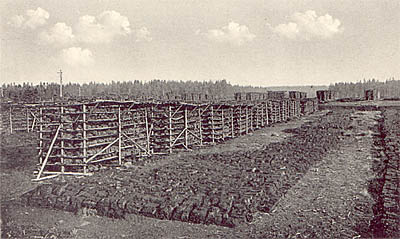Living in the country during the 19th Century in region Český
Region Český Krumlov has always belonged to rather poor foothill, cross-border regions of Šumava with an overriding craft production and agricultural production absolutely dominant in the country. Industrial has started to brew up in the second half of the 19th and the first third of the 20th Century. Local industry has been developing itself very slowly and a domestic character of production survived here for long time. From traditional economic professions thrived here only paper and textile industries, small production of weavers and glass blowers, extraction and processing of wood and peat or graphite mining. Home handmade production has been processing and using wood from the Šumava´s forests as a basic raw material for making tools, kits, furniture, matches or wooden shoes.
Hilly area of Šumava sierra with unpleasant weather conditions and less fertile lands sharply affected the structure and density of inhabitation, which has belonged to the weakest in Bohemia. Unpropitious economic development of area and limited agricultural opportunities forced part of inhabitants to emigrate and to seasonally work in the outback or abroad. Till the middle of the 20th Century belonged the region Český Krumlov traditionally to verbally and nationally mixed region with inhabitants of both Czech and German inhabitants.

|

|
Although the region Český Krumlov used to be one with prevailing agricultural production, it belonged due to unfavourable weather and soil conditions to areas less fertile . All common undemanding crops were grown here - barley, rye, wheat, oats, millet, buckwheat, pea, technical crops as flax and hemp. Origin of growing potatoes in region Český Krumlov springs between years 1758 - 1760, although their usage as food for cattle and humans was facing mistrusts, which lasted till the beginning of the 19th Century. In few climatically more pleasant areas used to be grown hops as well. (History of an agricultural production in region Český Krumlov)
Till the middle of the 19th Century survived on fields three-year system - winter wheat, spring wheat and wasteland, what means that all land was divided into three parts, on which have been sown the winter and spring wheat and on the third part has been not been seeded anything and served as a pasture. Agriculture had to ensure food enough not only for humans but also for cattle, which returned needful organic substances back to soil in form of manure, because the lack of natural manure caused an exhaustion of soil. During the second half of the 19th Century has expanded the system of crop changing in four-year cycles without using the wasteland. Due to the technical development have appeared the first seeding and mowing machines, mowers, threshers and roping machines. In spite of this has been agriculture through whole second half of the 19th Century accompanied by agrarian crisis and its negative impact has had World War I as well. Except for establishment´s manors of nobility and clerical dignitaries has been farming here also a number of middle and small farmers, whose fields were separated by milestones.
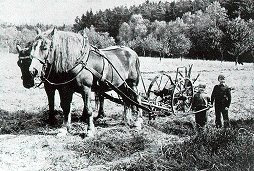
|
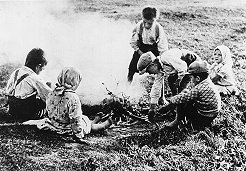
|
Labour on fields was every year ended by autumn tillage, which was
carried out by wooden or iron pulled one-shared plough using power
of oxen, cows or horses. The strongest and the most reliable
animals harnessed to wains and agricultural machines were the oxen,
small peasants harnessed cows and on the beginning of the 20th
Century extend using of horses. To wains and machines were animals
harnessed with yoke harnesses (horses) or just yokes (cattle).
Basis of the next harvest has been given at the Spring (spring wheat) or at the Autumn (winter wheat), when the fields were seeded. But first the field had to be prepared by hauling with all iron "gates" and smoothed with roller. Corn was the most frequently seeded manually from a flax apron made around the waist, later were used the seeding machines. From smaller areas was the corn gathered with a sickle, whit which was mown grass too. More powerful gathering tool was scythe, whit which mowers gathered grass from meadows and corn from fields. The scythe consisted from shank with two handles and iron scythe, which was before harvest sharpened by tenderizing on "goat" (oblong stool with a small anvil). Directly on field mower sharpened his scythe with a whetstone, which he carried attached to belt in metallic or wooden quiver. For harvesting the corn was handle of scythe specially adjusted. Later was the work of mowers replaced with lot more powerful mowing machines and reapers.

|
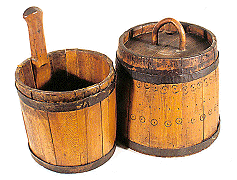
|
Mown grass on meadows was during preparation of hay - haymaking several times a day flipped and piled with wooden rakes. Heaps of hay were stored in the haylofts. Even here was manual work of humans replaced by raking machine. Mown cereal spikes were tied by pickers into the sheaves by ropes from corn stalks and stood them up. And manual power used during harvest was replaced by mowing and roping machines, which at once cut and roped corn into the sheaves.
Grain was from cereal spikes released by sledging with flails, separated from husks with sieves and clean was stored in granary. Tiring labour of sledgers was replace by manual and steam threshers. Straw from cereal stalks was used cattle bedding and production of ropes, mats, baskets, hampers and thatches for covering roofs.
Other important technical crops grown in region Český Krumlov were poppy seed and flax. Flax was processed into the flax cloth or were used its oily seeds. Remarkable was also the production of utilitarian items knitted from willow wickers - baskets, hampers, trugs and brooms from birch wickers. Supplementary and necessary form of domestic farming was also the bee-keeping and honey production.
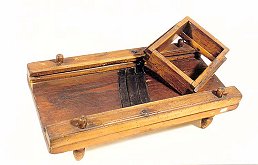
|

|
Quality and level of country dwelling of our ancestors relied not only on their social stance and financial possibilities but also on geographic, climatic and nationality conditions, that is why is in region Český Krumlov folk architecture and living conditions relying on it very various. For this area is typical distinctive quadrilateral closed build in brick rustic farmyard surrounded from all four sides by living, agricultural and farming. In direction to Czech up-country appears the original South bohemian rustic baroque, which is known for its rich plastering decorations of facades and house shields. The original development kept also the Šumava area with majority of German inhabitants, who protected their traditional wooden timbered buildings, because wood used to be in this hilly area the cheapest and the most accessible building material. For Šumava typical buildings have a character of timbered cottage in which were (under one roof) living room, pantry, black kitchen, cowshed, barn and woodshed. Such a cottage was entered through the entrance hall and people than walked through the whole house. On such a solution of living space had the main influence long lasting winter with lot of snow, that is why everything had to be easily accessible, because people in Šumava lived in straggly village solitude houses and could not bank on help from others.
Also level of housing varied according to wealth of family. In cottages family lived, slept, worked, cooked and kept poultry and small domestic animals, in rustic farmyards were living areas separated from farming buildings and owner´s family lived in room, old parents stayed "na vejminku" separated from farmer´s family and grooms lived in larder, stable or barn.

|
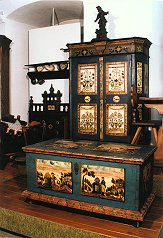
|
Center of every building was a spacious living room (also called sednice), where run all family life and house works, where women cooked, purred, wove, processed feather and men repaired and produced tools, knit baskets and brooms, carved wooden shoes or chopped spills for burning. Arrangement of furniture in room was not accidental. It came out from long traditions - benches along the walls and oven, table in the corner, under window corner bench with carved backrest, around chairs and stools, above table crucifix and "holy pictures" slightly lopsided, under the crucifix a threeside closet - "koutnice-corner closet" for valuable items and documents, in opposite corner bed for farmer and his wife, chest, closet, shelf for tableware, cupboards called "misníky", by the door a stoup filled with sanctified water and in the Winter a loom or spinning wheel.
Equipment of the country households was very simple, modest and clearly practical. Center of home processes was massive table with a footrest shaped and assembled from several parts. In the corner behind the table and along the walls and by oven stood a bench often with decorated backrest, besides stood in room "working" benches without backrests, chairs with variously shaped armrests and several stools and footstools. Very expressive was folk painted furniture - closets, chests, beds or cupboards, which have in this part of Bohemia typical blue ground with fillings and various geometric, vegetal and animal patterns and motives (hearts, roses, cornflowers, birds, deer) and only exceptionally and rarely appeared on furniture human creatures or action topics. Almost one fourth of the living space occupied an oven with tiled stove added on it. This stove served for bread baking, cooking and also for heating and water warming. The oven was accessible from adjacent hall or black kitchen. Near to the stove under the ceiling were suspended perches for drying of linen and duvets. Till the 19th Century were rooms lighted with wooden chopped spills attached into handles by an iron holder, later on were rooms lighted by candles and paraffin and oil lamps.
Such a room was accessible from an entrance hall, from which could one enter also a black kitchen and pantry, where the eatables were stored together with tools and sometimes even clothes. In some country cottages was from an entrance hall accessible a cowshed.
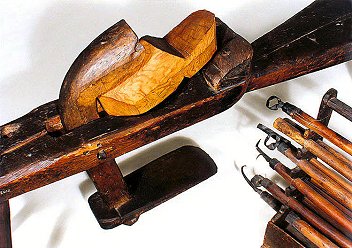
|
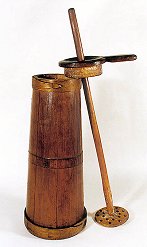
|
Living conditions of the Český Krumlov region inhabitants was chiefly determined by a character of surrounding nature - Šumava´s foothills and especially the central Šumava, which is created by 140 km long continuous belt of sierras with beech-fir forests in foothill areas, spruce forests in mountain areas, mountain meadows and pastures, peat bogs and numerous peaks.
The Inhabitants of Šumava, living in harmony with a nature, struggled to take advantage of all "forest´s gifts"; they used local wood as raw material for production of tools, kits, matches, wooden shoes, furniture, musical instruments (resonant wood) and as well as combustible for homes and glass production or as a basic building material. Local extracted wood used to serve for needs of locals and for their home production of the utilitarian things for households (wooden shoes, stirrers, spoons, pipes, toys, farming tools and kits). Than with growing market and extraction the greater part of wood was transported out of the area of Šumava and from the 19th Century has developed an industrial processing of wood with its roots in local traditions - production of furniture, ledges, frames, shingles, building parts and paper.
After the end of the 18th Century the wood extraction has expanded even to further parts of Šumava´s forests, where were established the first lumberjacks settlements. Thanks to protection and plantation of forest appeared here the very first forest monocultures - forests of only one type of wood, which later on replaced the original mixed virgin forests and were later hit by great calamities - 1870 wind fallen trees and 1881 snow calamity followed by calamities of insects and destructive forest fires. Each strong windstorm insects´ calamity were always followed by grow of wood extraction, because forests had to be quickly extracted, processed and cleared.
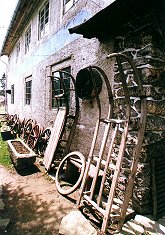
|
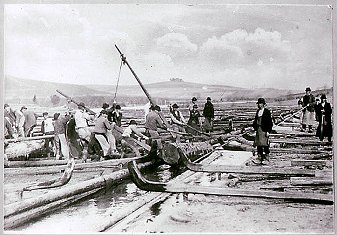
|
Extracted wood was transported to brooks, from where was shipped to local sawmills motored with water power, or was partly processed hauled to the up-country. The most important nature water channel was Vltava river, on which was the wood from Šumava forests transported to Czech up-country or even further to Northern Germany. On the upper stream of Vltava river was wood transported in untied state and on the middle and lower streams was wood tied into the rafts. Modern kind of transport of wood from Šumava has been in this direction ensured since 1892 by newly built railroad České Budějovice - Želnava. Lack of wood in Austrian up-country at the end of the 18th Century catalyzed the construction of the Schwarzenberg´s navigational canal, along which were the logs transported from inaccessible and not used Šumava forests around the Plešné lake into Mühl river and from here along the Danube to Vienna. (History of transportation in region Český Krumlov)
Shortage of quality firewood during the 18th - 19th Century led the local inhabitants living around the upper stream of Vltava river, in areas permanently impregnated by water with large peat bogs, to mining of easily accessible peat as a fuel - so called "borkování". From the uncovered and drain wall of peat deposit was manually with special spades cut off single peat bricks - borky, which were consecutively dried in stacks or on wooden dryers. In the 19th Century usage of peat extended as field manures and cultivation substratums and as insulating material in the industrial production.
Neither agricultural nor wood processing countryside could not in the past exist without smithies and hammers, which ensured a sufficiency of frequently used tools - axes, hammers, tongs, mattocks, sickles, scythes, spades, shovels, ploughshares and nails. Their most important parts were an anvil, furnace with a chimnney and bellows connected to it, by which the air was driven into fire in order to reach higher temperatures. The great smithies - hammers, which were built near the brooks and rivers, because their working needed sufficiency of water, which motored the great hammer - "kobyla-a mare", served especially for production of greater semifinished products. In the smithy, which could be built separately or as a part of the hammer, was thermicly processed iron shaped on anvil by a gavel into the final form.
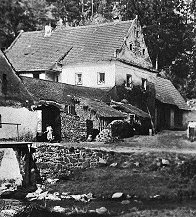
|
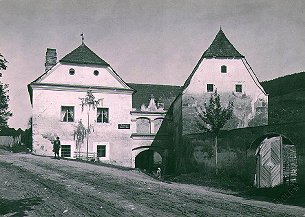
|
Šumava´s uphill as well as Novohradské mountains played very important role in the Czech glass industry, because local forests provided lot of firewood and raw materials needful for numerous vernacular glassworks. The oldest references present the first Šumava´s glassworks since 1359. Products of local glass manufactures were very various from pane and mirror glass to luxury drinking services decorated by carving or painting, which were through the ages adapted to a period taste and style.
Development of glass production at the Buquoy´s manor Nové Hrady arrived in the 17th Century supported by Marie Magdalena de Biglia, the wife of the first owner of the manor Karel Bonaventura Buquoy. Then the glassworks at manor Nové Hrady produced mainly glass decorated by carving - bowls, chalices with tops and smaller cups. Between years 1673 - 1689 glassworks in Eggenberg´s and Vimperk manors managed to discover almost simultaneously clear crystal glass. Except for clear crystal glass produced the glassworks also coloured glass - blue, green, yellow, ruby and even violet. During the 17th and 18th Century obtained Czech glass from Šumava admiration in the middle European area, from where progressively replaced production from Venice. Šumava mountains has been the area with the greatest concentration of glassworks in Bohemia (at the end of the 18th Century have been 41 out of 64 in Bohemia).
Into the history of Czech glass-blowing remarkably entered himself count Jiří František August Buquoy (1781 - 1851), naturalist and physicist, who invented (based on an experimentation) the original technology of production of a black opaque glass - hyalite (year 1817) and replenished production with red hyalite (year 1819).
In the first half of the 19th Century become the most famous the Schwarzenberg´s Šumavian glassworks in Adolfov, named after prince Jan Adolf II., and in Lenora, which was named after Adolf´s wife Eleonora, because they have paid to glass-blowing an extraordinary attention. The gradual downfall of glassworks in Šumava occurred since the middle of the 19th Century due to cheaper competition, declining interest in glass products, exhaustion of local wood sources and also fuel crisis in both Czech and Austrian up-countries.
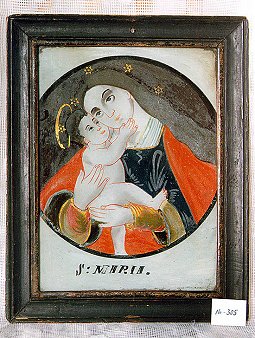
|
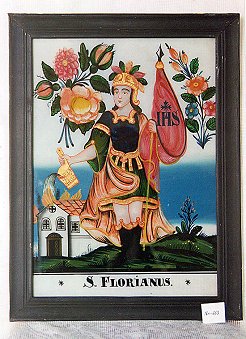
|
Tradition of glass-blowing in the region Český Krumlov reaches back to the Middle Ages with the oldest record from year 1379 about Glass works at the manor Vítkův Hrádek. Also names of others prompt about glass blowing - Stará huť u Ktiše (Old glass work by Ktiš), Stará huť u Horní Plané (Old glass work by Horní Planá) or Skláře u Hořic na Šumavě (Glass-blower by Pohoří na Šumavě). Since 1693 glass work in Pohoří na Šumavě has produced large pane or mirror glass, rests of the glass panes used local glass-blowers for home-made folk paintings on glass, chiefly with religious motives and figures of saints, which found their sale on fairs at home and abroad. Among the greatest glass-works in region Český Krumlov belonged the glass work and grinder´s in Josefův Důl by Horní Planá founded in 1823. (History of glass-blowing in region Český Krumlov)
Origins of the industrial business in region Český Krumlov were very modest, because lack of raw materials, investments and capital, insufficient net of roads and railroads and shortage of greater amount of working power caused the backwardness of the whole area, because local manufactures and later even factories dependent on local raw material resources and long-standing tradition based on simple production programs, employed only 3,9 % inhabitants of region. (History of industrial production in region Český Krumlov)
In region Český Krumlov did not develop many industrial companies and heterogeneity of their production was not rich - ironworks in Holubov, foundry and engineering plant in Zlatá Koruna, frame producing factory in Český Krumlov, match production in Zlatá Koruna, flax spinning factory in Nové Spolí by Český Krumlov or cloth factory in Český Krumlov.
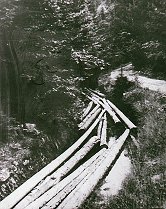
|
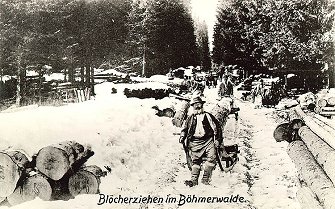
|
On the local rich tradition of paper production, reaching back to year 1572, connected in year 1861 Ignác Spiro (1817 - 1894), who bought Pachner´s Krumlov paper mill. After destructive fire of Krumlov paper mill in 1866, when has been almost all making destroyed, bought Spiro in 1867 Pečky mill by Větřní, in order to build here wood grinding factory and later on the paper mill too. New, industrial, period of this paper mill has started in 1911, when was in factory (specialized on production of wrapping and printing paper) built steam rotary paper machine, then the greatest one in the world. The second paper mill was founded (originally as sulphite cellulose production) in 1884 by Arnošt Porák in Vltava mill by Loučovice. Its production has been in time aimed to output of pasteboard, carton and wrapping paper.
Although Český Krumlov belongs to regions with modest mineral wealth, it has varied history of mining silver, gold and graphite. The oldest written record about silver mining comes from year 1475 and the greatest mining boom arrived between years 1519 - 1550. Exhaustion of mineral resources has been followed by decline of mining activities, but in next Centuries (17th and 18th) were carried out attempts to renew silver mining naturally without success and mining in region Český Krumlov definitively ended in year 1849. In period when silver mining in region Český Krumlov has been on the decline and gradually perishing, was here started graphite mining at the beginning of the 19th Century. The greatest resources of graphite and at the same time the oldest graphite mines in region Český Krumlov have been located in vicinity of Černá v Pošumaví, Hůrka, Mokrá and Bližná, where the mining was opened in 1811, although the first records about graphite mining in this area come from year 1767, when was the lead capturing by local farmers without mining. It has been used as lubrication of wooden cart or as polish. In year 1811 has been graphite declared as stipulated mineral and its mining came under mining regulations and laws, officially could be opened the Schwarzenbergs mines in Černá v Pošumaví and its vicinity. Local production has at first been processed during production of foundry heat-resistant melting pots and in pencil producing factories in Zlatá Koruna and České Budějovice. Increase of demand for graphite around year 1846 led to opening of new graphite mines right in Český Krumlov , which met the boom of mining between years 1897 - 1906, when Krumlov mines of the Poráks brothers exported pressed blocks of refined graphite to Germany, Great Britain and America.
(mj)
Further information:
History of Mining in Český Krumlov
Economic History in the Český Krumlov Region
History of Transportation in the Český Krumlov Region
Cultural History of the Český Krumlov Region
History of Education in the Český Krumlov Region


